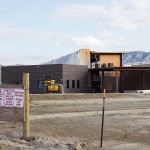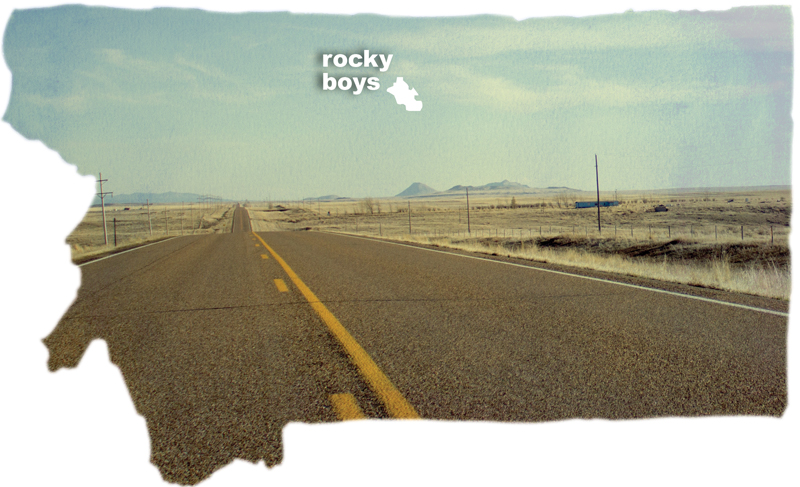Rocky Boy’s
Rocky Boy’s – Symptoms of Spending
- The new Rocky Boy’s health center was supposed to be finished in spring of 2013. It has since been delayed and remains $15 million short from completion. The medical center stands as a symbol of the economic difficulties plaguing one of the smallest reservations in Montana.
- After receiving a letter from BEH Gaming Ltd. claiming the tribe owed more than $16 million for the construction of a hotel onto the Northern Winz Casino, Ken St. Marks began questioning the financial state of the tribe. He says the tribe is in nearly $50 million worth of debt and argues some of that is a direct result of misspending.
- People going into the tribal chambers during Ken St. Marks’ impeachment hearing were met by guards at each entrance and subject to being searched with a metal detecting wand.
- During his impeachment hearing, Ken St. Marks refused to enter the Tribal Chambers in protest of what he claims was an unconstitutional process of impeachment. Along with him were nearly a dozen of his supporters vocalizing their distrust of the tribal council.
- Ken St. Marks was removed from the Chippewa Cree Business Council amid accusations of employee harassment, financial misconduct and illegal employment practices. He says this was a cover for the tribal council’s dissatisfaction with his cooperation with federal investigators into tribal misspending. Here he is at his house located just above the hill above Rocky Boy Agency.
- Because it’s difficult for Barbara Eagleman to receive adequate health care at the temporary clinic, her granddaughter Glenda must help with daily activities and medical transportation. The Eaglemans claim the only way to see a doctor at the temporary clinic is to go by ambulance, which is more costly and uncomfortable for Barbara.
- Suffering from chronic back pain, respiratory issues and a heart condition, Barbara Eagleman is forced to travel to Havre and Great Falls to receive the necessary health care for her problems. Lack of funding, she claims, has resulted in a dismissal of the medical transportation program and the in-house health checkup she was supposed to receive.
- Even after receiving certificates for construction and carpentry, Will Gopher has difficulty finding work on the Rocky Boy’s reservation, which he claims is a result of his lack of favorability amongst the tribal council. Instead, he beads jewelry sold in the neighboring town of Havre.
Story by EBEN WRAGGE-KELLER
Photographs by THOM BRIDGE
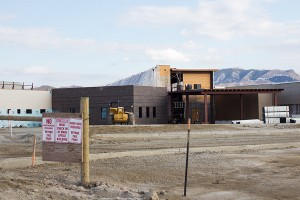
The new Rocky Boy’s health center was supposed to be finished in spring of 2013. It has since been delayed and remains $15 million short from completion. The medical center stands as a symbol of the economic difficulties plaguing one of the smallest reservations in Montana.
Three police officers stood outside the front door of the Chippewa Cree Business Committee chambers on the cold, spring morning. Inside, security guards waved a metal-detecting wand over employees before they were allowed to enter the tribe’s legislative chambers.
Out back stood three more police officers, blocking the door from the 12 Rocky Boy’s citizens there in protest. Among them was the man at the center of the day’s controversy and enhanced security detail, Business Committee Chairman Ken St. Marks.
Standing with his supporters, St. Marks was already sure of the council’s vote. He was certain of the outcome as the council members deliberated whether to remove him, the tribe’s elected tribal council chairman, from his position. But when the verdict was final, proving him right, his voice still carried a tone of disappointment.
“I’m kicked off the council,” St. Marks said.
Surprised at the thought, a supporter, Russell Standing Rock, asked him to clarify.
“They kicked me off. I’m off the council.”
The Chippewa Cree Business Committee, the governing body of the 6,177-member tribe based on the Rocky Boy’s Indian Reservation, voted to remove St. Marks as chairman. The event came six months into his term, which was filled with accusations from both factions regarding misspent tribal funds and alleged corruption.
The council leveled a number of accusations against St. Marks: employee harassment, sexual harassment, financial misconduct, unauthorized expenditures and illegal employment practices.

Ken St. Marks was removed from the Chippewa Cree Business Council amid accusations of employee harassment, financial misconduct and illegal employment practices. He says this was a cover for the tribal council’s dissatisfaction with his cooperation with federal investigators into tribal misspending. Here he is at his house located just above the hill above Rocky Boy Agency.
On the other hand, since he was elected chairman, St. Marks has filed his own claims against the council and has asked for a federal investigation into the council’s spending.
Coincidentally, in a separate federal investigation, a member of the tribe’s business council was indicted in U.S. District Court on charges of embezzlement in early May.
Council delegate John Chance Houle, along with the head of Chippewa Cree Construction Corp., Tony Belcourt, and three others were indicted on charges of misspending more than $300,000 of federal American Recovery and Reinvestment Act funds.
St. Marks began making waves early in his term. In February, he received a memorandum from BEH Gaming, a Florida-based limited liability corporation, claiming the tribe owed the company more than $16 million for the construction of the tribe’s Northern Winz Casino. But upon asking for formal documentation, St. Marks said he was immediately met with resistance.
“My question to [the council] was ‘Where did the money go?’” St. Marks said. “As soon as I asked that question, they turned on me and voted me out of there.”
In the BEH memo, the company stated the tribe had agreed to make monthly payments upward of a quarter of a million dollars. Instead, the company stated, it had only received one payment of $10,000.
The council provided no comment. Kerey Carpenter, general counsel for BEH, verified the company is based in Florida but would not give any information regarding its business with the tribe or with the Northern Winz Casino. Beyond that, BEH has no official listing or online presence. Its existence is solely determined by the court documents and the letter sent to St. Marks alleging the tribe owed $16 million.
This was the first in a series of troubling finds in the tribal council budget, which St. Marks claims is in debt by nearly $50 million. It is also the reason there is only a shell of a new medical center sitting in town, incomplete and unattended.
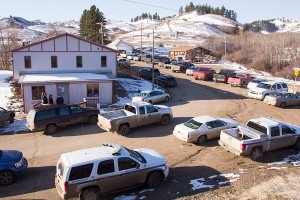
After receiving a letter from BEH Gaming Ltd. claiming the tribe owed more than $16 million for the construction of a hotel onto the Northern Winz Casino, Ken St. Marks began questioning the financial state of the tribe. He says the tribe is in nearly $50 million worth of debt and argues some of that is a direct result of misspending.
This story is not new. Tribal governments throughout the United States are constantly under scrutiny for how money is spent. On Rocky Boy’s, the story continues to play out with the most recent indictments regarding the federal reinvestment and recovery money.
In July 2012, the Department of the Interior launched a federal investigation into the North Central Montana Regional Water System Project designed to bring clean water to Rocky Boy’s and surrounding areas. Among the initial findings, the inspector general discovered that some of the $33 million in federal funds designated for the $361 million project had been diverted into private business accounts. The money was eventually replaced, but the inspector general shut down the pipeline project until the tribe can implement tighter accounting regulations.
According to the indictment document, Houle coordinated with four others—Tony Belcourt, Hailey Lee Belcourt, and Tammy and Mark Leischner—to create a surrogate company, MT Waterworks, used to perform a complex series of transactions that funneled federal stimulus dollars into private accounts.
Among the alleged illicit transactions are using money to buy a house and to finance private businesses. In total, the group is charged with misspending $311,000.
Tribal governments and misspent money seem to be a common focal point in media coverage of Indian Country. That’s not to say the phenomena doesn’t exist, but the reasons behind these incidents have a common thread. Recognized tribal governments are relatively new and still finding balance between traditional and contemporary policies, said University of Montana School of Law professor Maylinn Smith.
“Part of the problems I see with tribes, and Rocky Boy is not unusual in this, is that they’ve had government structures somewhat imposed on them that really do not meet their cultural needs,” Smith said. “They’re trying to work in a system that does not build on consensus, that does majority vote.”

People going into the tribal chambers during Ken St. Marks’ impeachment hearing were met by guards at each entrance and subject to being searched with a metal detecting wand.
Smith has been practicing Indian law for 26 years, and during that time she has seen accusations of corruption on tribes across the state. The problem, she says, isn’t the people. It’s the power.
“I think any government is corrupt,” Smith said. “You’re going to get corruption in any government. And I think that the stereotype that may come across is the corruption in Indian Country really is more of a reflection of tribalism, tribal communities, clan systems. Where historically, as part of tribes you are supposed to support your clan, your family members.”
The council refused to comment. But, according to court documents, the Business Committee filed a restraining order against St. Marks by the Business Committee on March 15, 2013. The courts dismissed the restraining order six days later, after the committee had refused to present any specific accusations.
Will Gopher was released from prison last winter and has been living in a condemned home with his nephew through the last few months. He spends the majority of his time making brightly colored beaded jewelry—necklaces, earrings, bracelets—and selling them to a store in Havre to help keep the lights on. In the summers he fights fires, but in the fall, winter and spring, he struggles to pay the bills.
The home, which has mold and wood-rot issues, is all Gopher can afford. But during the colder months, he must turn on the stovetops in the house to stay warm or burn a small allotment of wood brought in by the Forest Service.
“Well,” Gopher says, flicking his cigarette out the doorway. “You gotta be good with the council, that’s all there is to it.”
Gopher has spent his whole life in Rocky Boy’s. During his time in prison he earned multiple construction and carpentry certificates, but since his release, he hasn’t been able to put any of his newfound skills to work. As he looks around his home, he assesses the costs at around $6,000 to make it livable again.
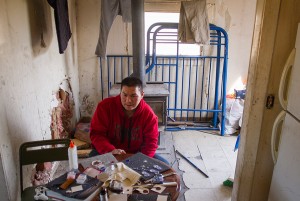
Even after receiving certificates for construction and carpentry, Will Gopher has difficulty finding work on the Rocky Boy’s reservation, which he claims is a result of his lack of favorability amongst the tribal council. Instead, he beads jewelry sold in the neighboring town of Havre.
In his time on the reservation, he’s felt as though there hasn’t been the kind of disclosure necessary to keep the tribal members informed. The tribal council members’ salaries are, in particular, a sore subject.
According to St. Marks, who also served as a tribal councilman in the early 2000s, council delegates earn more than $100,000 annually, while the head of the council earns an extra $20,000 on top of that. With eight council members on payroll, nearly $1 million of the tribal budget goes to their salaries alone. Some council members have businesses, ranches and other forms of income on top of this.
Gopher points out that a delegate earns more in one month than he did in a year working at a local sports bar and restaurant, where he took home $520 every two weeks, $620 if he took extra shifts.
“It’s kind of hard to understand why we’re so poor, when we get all this funding and we can’t even get a tank of gas, or a $50 food voucher,” Gopher said.
He is representative of the 65-percent unemployment rate on the Rocky Boy’s reservation, but he hopes to earn enough money over the summer to fix up his home and make it livable. He goes down to the tribal council headquarters every day to ask for work and claims he is widely ignored or told there is nothing for him to do.
Meanwhile, nearly half of households in Rocky Boy’s live on less than $25,000 per year. According to the 2011 U.S. Census Bureau information, the average household in Rocky Boy’s has a median income of about $27,000.
Rocky Boy’s is home to two very different scenes: low-income housing and brand-new buildings with modern designs that could rival more affluent, metropolitan areas. A brand-new law enforcement building sits, casting sharp, angular shadows on the trailers across the street.
A few hundred yards up the road sits another building, unpainted walls of Sheetrock draped in opaque plastic sheets. The Chippewa Cree Medical Center sits unattended, a symbol of the economic troubles plaguing one of the smallest reservations in the state.
The construction of the new medical center is short $15 million dollars and has only recently resumed construction after the tribe received a $5 million loan. Though 20 new employees were just hired, there is still no word as to where the remaining money will come from and much disagreement about where the money went.
Ted Demontiney has been on the business committee less than a year. By the time he was elected, the new clinic had already begun construction, thanks to loans from tribal businesses with the understanding that they would be reimbursed when an anticipated insurance check arrived.
“They had $25 million and they split it. $12.5 million went to the clinic,” Demontiney said about the insurance check. “They must’ve hired too many people, and that kind of put them in a financial strain. They split the other $12.5 million into four different programs that needed some bailing out, paying out loans and some debts that they had from other programs.”
The hospital project, initially estimated at $22 million, has now breached the $30 million mark. The new completion date has been pushed back to 2014.
Without the funds to build the new clinic, tribal members are forced to leave the reservation for medical care during after-hours operation using the Indian Health Service Contract Health Service program, which contracts with outside hospitals to provide care to tribal members. Driven by funding shortfalls, medical center officials have drafted a system in which they gauge the severity of a patient’s symptoms to determine whether they will receive treatment.

Because it’s difficult for Barbara Eagleman to receive adequate health care at the temporary clinic, her granddaughter Glenda must help with daily activities and medical transportation. The Eaglemans claim the only way to see a doctor at the temporary clinic is to go by ambulance, which is more costly and uncomfortable for Barbara.
St. Marks said his tribal political career was driven by the story of a friend who unsuccessfully sought treatment at the medical center. She had complained about a pain but was sent home with aspirin.
“She’d go back every day,” St. Marks said. “Finally, one day she got so sick they rushed her to the hospital. They flew her to Great Falls, and she died a couple days later. Cancer.”
Glenda Eagleman has been taking care of her grandmother, Barbara, for the past few years. Over time, Barbara’s condition has grown steadily worse and has resulted in several trips to the Havre or Great Falls hospitals per week. Each time, Glenda claims her grandmother is given some pain medication and sent on her way.
On May 6, Barbara was diagnosed with malignant cancer.
Years earlier, Glenda lost her daughter to an asthma attack. She claims it took the ambulance 45 minutes to drive to her house, three miles down the road.
“When we went and checked on her before we go to bed, and I noticed that her eyes were open. I went and checked on her, and her brothers were with me, and I checked her pulse, I noticed she wasn’t breathing. Right away I started CPR,” Glenda said.
Officer Larry Bernard arrived at the Eaglemans’ home shortly after the family called 911 and assisted with multiple shifts of CPR while waiting for the ambulance to arrive.
“I often wonder if they would have gotten her to Havre right away, if they could’ve started that shock treatment and adrenaline in her heart, if she could’ve had a chance,” she said.
Resorting to Contract Health Service is costly and the tribe owes up to $4 million to outside specialists, Demontiney said. “And we’re making it a priority to pay those bills out there so we can see the specialists and continue the services,” he said.
But things are expected to get worse before they get any better for the tribe. In March 2013, the first of the federal sequestration budget cuts were made and are expected to impact Native American reservations across the country.
“The sequestration hit all across the board on everybody, and we’re prepared to do what’s necessary on all the budgets, all the line items,” Demontiney said. “It’s gonna start hitting us pretty soon, probably in the middle of this month we’ll start feeling the lesser money. It will get worse, yeah, but you gotta prioritize and make sure that your adjustments are necessary for survival of the businesses.”
Since the Indian Reorganization Act was passed in 1934, the vast majority of tribes have outlined protections designed for these types of situations in their tribal constitutions. But not every tribal member is aware of the power they have if they act as a group.
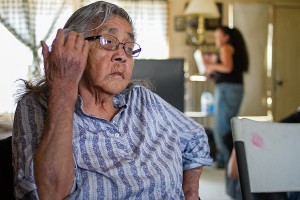
Suffering from chronic back pain, respiratory issues and a heart condition, Barbara Eagleman is forced to travel to Havre and Great Falls to receive the necessary health care for her problems. Lack of funding, she claims, has resulted in a dismissal of the medical transportation program and the in-house health checkup she was supposed to receive.
“Part of this is that I think tribal people have been subjected to so much top-down authority, through the BIA or whatever, that they have not appreciated the level of action they can take as a citizens’ group,” Smith said.
Article VIII of the Rocky Boy’s tribal constitution outlines a tribal citizen’s right to organize and petition the government. But Smith, with the University of Montana law school, said she has never heard of it being used.
“It is a huge tool for the populous, your tribal general membership, to use to make changes in the government,” Smith said. “But you have to have someone who can organize the people, and that’s where you have those divisions along family lines often that make it difficult to make that majority vote.”
Smith said St. Marks is making use of his rights, but if tribes really want to make changes, the most dramatic change doesn’t occur from the top-down. It starts with the people.
 Native News Project 2013
Native News Project 2013